The absolute beginner is a good method to start with, however this method will give you a better basis for learning the fridrich method. Luckily, it is similar to the beginner method, and the first four are absolutely the same. So, before learning this method, you should be familiar with the first four steps of the beginner method. And of course, you should be familiar with the notation and locations as well.
After you've made the yellow cross, the method differs from the beginner's method. In stead of first solving the edge pieces, we're first completing the yellow side. This step can be seen as orienting the corners. After you've oriented both the yellow edges and the yellow corners (the previous two steps), you can begin placing the corners and after that the edges. So, after the first four steps, this are our steps:
- 5. Orienting the yellow corners;
6. Placing the yellow corners;
7. Placing the yellow edges.
Step 5: Orienting the yellow corners;[]
After you've made the yellow cross, you will now have one of the following situations:
- Four yellow stickers are on top;
- Two yellow stickers are on top;
- One yellow sticker is on top;
- No yellow stickers are on top.
Note that we are only talking about stickers of cornerpieces. We ignore the stickers of the edgep
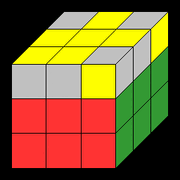
Facing up in UFL, towards you in UFR.
ieces for now.
Four stickers[]
When you find yourself in the situation in which all the four stickers face the ceiling. When that happens, you have already completed this step, and you can skip to step 6.
Two stickers[]
When you have two stickers on top, you will have to hold an unsolved piece at UFL, by either turning the entire cube, or turning the top side. Then, check if that piece has its yellow sticker facing towards you. If the yellow sticker is at the left side, get the other unsolved piece in that
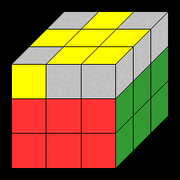
Facing up in UFR, towards you in UFL.
position. That piece will have a yellow sticker facing towards you. At last: turn this algorithm (the same one of step 5 of the beginner's method):
R U R' U R U2 R'
Now, you will have only one yellow sticker facing the ceiling. What to do next, is explaned below.
One sticker[]
If you have only one sticker facing up, hold that sticker in UFL. Then, check if there is a yellow sticker facing you in UFR. If yes, turn this algorithm (again):
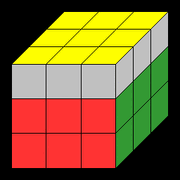
Yellow side made.
R U R' U R U2 R'
If not, hold the sticker pointing up at UFR. Then, you will have a yellow sticker facing you at UFL. Then, turn this:
L' U' L U' L' U2 L
No stickers[]
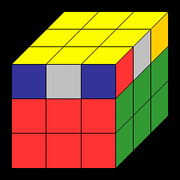
Example of two the same colours on the same side.
If you do not have any yellow stickers facing up, make sure you have no yellow sticker facing towards you. Then turn the algorithm:
R U R' U R U2 R'
Now, you will have one sticker facing up.
You should now be able to make the entire yellow side.
Step 6: Placing the yellow corners[]
In this step we're gonna place the yellow corners. First of all, check if you
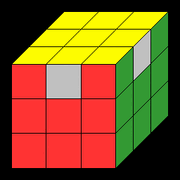
This is what it looks like when it's solved.
have two the same coloured stickers on the same side. (If you have this on four sides, that means you've already solved it.) If you do, turn the top layer, until they are at the back side. Next, turn this algorithm:
R' F R' B2 R F' R' B2 R2
Now, you can, by turning the top side, place every single corner.
If you do not have any side on which there are two the same coloured stickers, just turn the algorithm and you will have one.
This step wasn't very long, was it? The last one will not be very long either, but the algorithms are longer than the ones of the beginner method.
Step 7: Solving the yellow edges[]
The last step in solving the cube. All the edge pieces have to be moved in groups of 3, and that's why you cannot have two or one unsolved edges. However, you can have four unsolved edges. I'll take care of that later.
When you have three unsolved edges, determine if they have to be cycled clockwize or counterclockwize. Then hold the solved edge piece at the back side. If they need to be cycled clockwize, turn th
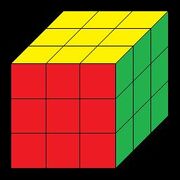
Solved rubik's cube.
is:
R2 U R U R' U' R' U' R' U R'
If they need to be cycled counter clockwize, turn this:
R U' R U R U R U' R' U' R2
If you do not have any solved edges, just turn one of the algorithms above, from any position. With this information, you should be able to solve the cube!